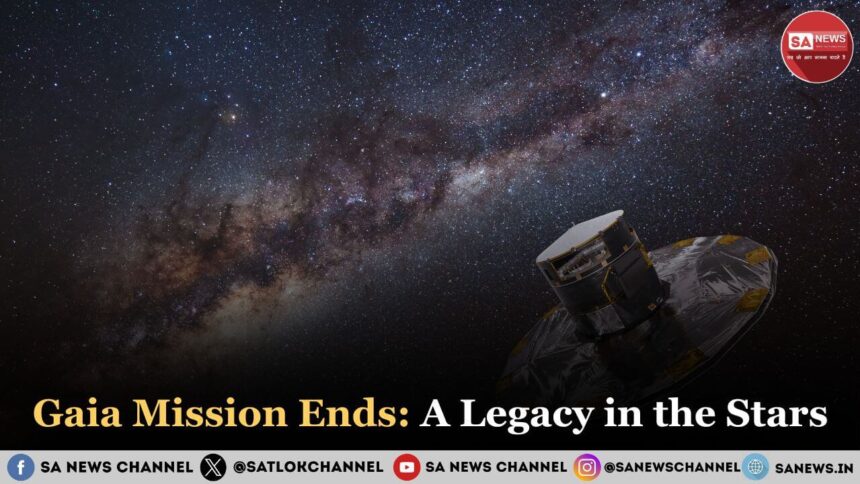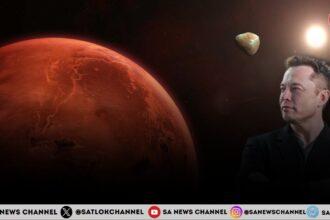The European Space Agency (ESA) officially concluded its Gaia mission on March 27, 2025, marking the end of an era in space-based galactic mapping. Launched in December 2013, the Gaia spacecraft was designed to create the most detailed 3D map of the Milky Way. After downlinking its final datasets, Gaia was decommissioned and moved into a stable retirement orbit around the Sun, where it will remain indefinitely without interfering with future missions.
Gaia Mission Background
• Gaia stands for Global Astrometric Interferometer for Astrophysics.
• The mission aimed to survey over a billion stars and trace their positions, distances, and motions.
• The spacecraft was stationed at Lagrange Point 2 (L2), about 1.5 million km from Earth, enabling minimal interference.
For detailed mission science, visit ESA’s Gaia Portal.
Technological Breakthroughs
Gaia was equipped with:
- Twin telescopes
- A 1-billion pixel digital camera — the largest ever flown in space
- Three major scientific instruments:
- An astrometer (for position)
- A photometer (for brightness and color)
- A spectrometer (for velocity and chemistry)
These technologies allowed Gaia to observe stellar motions and positions with exceptional accuracy.
Scientific Goals
• Survey over 1 billion stars in the Milky Way
• Build a highly accurate 3D model of the galaxy
• Investigate the structure, origin, and evolution of the Milky Way
• Provide foundational data for future missions and research
Major Contributions to Astronomy
• Gaia has collected billions of astrometric, photometric, and spectroscopic measurements over its lifetime.
• More than 2 billion celestial objects recorded
• 13,000+ scientific publications already based on its data
• Detailed mapping of the galactic disk, central bulge, and stellar flows
• Analysis of stellar ages, compositions, and movements
Gaia data also supports global astrophysics, cosmology, and planetary defense studies.
Black Holes and Asteroids
• Gaia helped detect new types of black holes that don’t emit light — only detectable by their gravitational influence
• Tracked over 150,000 asteroids, enriching our understanding of near-Earth objects and potential hazards
■ Also Read: Top Research Internships in India including Top IITs (Computer Science & IT)
Retirement and Data Future
• Gaia was officially deactivated on March 27, 2025
• Now located in a solar retirement orbit, far from Earth
• Remaining data will be processed in the post-operations phase
• The final Gaia Data Release (DR5) is scheduled for 2030, ensuring its legacy continues in scientific and academic research
Spiritual Perspective: The Inner Universe and True Knowledge
Just as Gaia traced the cosmos to map the Milky Way with unparalleled precision, humans too seek to map the path of the soul. According to Sant Rampal Ji Maharaj, true spiritual knowledge (Satgyan) serves as the soul’s navigation system — guiding one to understand their origin, purpose, and ultimate liberation. While Gaia decoded the stars, Satgyan helps us decode life itself. Where Gaia offered clarity of the universe, Satgyan offers clarity of the self — a pathway toward inner peace and eternal truth.
Legacy and Impact
Gaia mapped just 2% of the Milky Way’s estimated 100 billion stars, it laid the foundation for next-generation galactic and cosmological missions. Its data continues to drive research and open new questions about the nature of dark matter, stellar lifecycles, and the future of space science.
FAQs: Gaia Mission Final Phase
Q1: Who designed the Gaia spacecraft?
Ans: The Gaia spacecraft was designed and built by Airbus Defence and Space (formerly Astrium), under the direction of the European Space Agency (ESA).
Q2: Where is the Gaia spacecraft now?
Ans: In a retirement orbit around the Sun
Q3: Is Gaia still operational?
Ans: No, it was officially decommissioned in March 2025
Q4: What is Gaia’s Data Release 5 (DR5)?
Ans: The final release of processed data, scheduled for publication by the end of 2030
Q5: What is the spiritual takeaway from the Gaia mission?
Ans: Just as Gaia mapped the stars to understand the universe, Satgyan helps us map our inner being to attain true knowledge, peace, and salvation.









